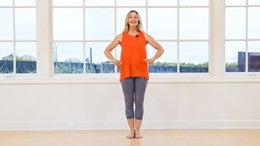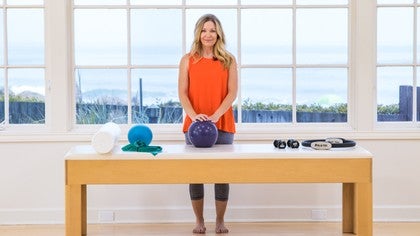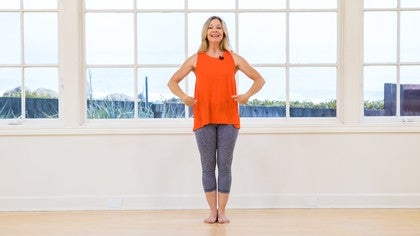Description
Props Mentioned
- Overball
About This Video
Transcript
Read Full Transcript
Hi everyone. I'm Amy havens. I'm an original teacher here for [inaudible] anytime and I want to welcome you to the website and to this online community. That is a wonderful and a really great place to learn your Pilati skills. So thanks for joining us. I'm going to overview the kind of the five most commonly used props that you'll see in mat classes, um, and equipment classes, but more so than that.
So there are about 40 that you'll see on our props list on our site. But I've chosen the most common five for simplicity. I'll start with the magic circle or sometimes called [inaudible] ring. So here's typically what it looks like. Foam pads on the outside. This one has a plastic cover, sometimes they are just the metal bands and they come soft and go all the way to more, um, sicker resistance.
So it's a lot of the work with the ring is providing additional strength work and control work, adding resistance, but also sometimes assistance to your exercises. You'll see classes that utilize this for head support. So sometimes you'll see it behind the head and underneath the back of the skull when doing abdominal exercises on the mat, you'll see a lot of use of the magic circle with arm and shoulder girdle work above the head to the side. A lot of times between the knees to squeeze and really target the inner thigh muscles. In standing work, we often put it between the ankles and the knees as well. So get ready to see a lot of classes with magic circle or PyLadies ring.
They're wonderful. I did suggest everybody try some, I'm moving onto hand weights. These are two pounds, but you will see classes that ask for one pounds two or up to three. And what do the hand weights do? Well, they're adding a lot of additional arm work, arm strengthening to the exercises, but classically or traditionally, we use these often to really help understand the rib cage placement along with how your arms are holding weight and how you're organized in your posture. You'll also see these lying supine doing abdominal work. Uh, also replicating some of the exercises that you'll learn on the reformer. Some teachers use those on the Mat. So these are very versatile props. We use them on equipment as well. Sometimes if the resistance on this spring, let's say on a reformer is too heavy, you may be asked to learn the exercise just with a hand weight to get the um, just the basic general motor skill pattern going and then adapt that onto the piece of equipment. So again, hand weights one, two, or three pounds.
And I'm going to move on to a foam roller. And just a quick bit about the foam roller. This happens to be probably one of the more common colors you're going to see in foam roller classes. You're a, you might be able to get them in a different color and a different density. Uh, this one, I'm going to say it's moderate density, meaning pretty firm. They do make them more firm and less firm. I would suggest trying a couple is sometimes sporting goods stores or things.
Do you have different varieties of these? Uh, if you know yourself to have a bit of a tender back or a tender spine, you may want to look for one that's less dense. Or if you can't find one that's less dense, and this is maybe all you have access to, uh, of what we've done before is put mats over the top of this to make it a little softer to lie on things you're gonna do on the roller though. Initially, as soon as you lie down your tailbone ob here, you'll be on your back and your skull will be here. So you're safe on the roller, but immediately as you're on this, it starts to move. So your opportunity to stabilize it or in your job to stabilize it right away demands you to kick in or your core muscles of your abdominals and spine to kick in so you won't fall off. It's, you may Giggle, you may have fun with it, which is encouraged. You'll probably feel your abs more anyway. Um, and there's lots of focus and attention put on how your spine is in contact with the roller. It provides a great deal of feedback for the musculature back there.
Um, again, you'll do are movements here that open up your chest. You'll be starting to do leg movements, picking one leg up at a time that really target the stability as well as the muscles in your lower abdomen. Uh, you'll progress into standing exercise with these also sometimes lying and doing, um, like self massage techniques or lying on it. And sometimes we call it rolling it out or rolling out tension. Uh, certain classes on our site involve those, but more often than not, you're going to use these for challenging your middle, your core. Uh, and again, they do come in different densities. This is also, I think the most commonly, uh, accessible roller that you'll find. All right, I'm gonna move on to another prop and this is a resistance band.
Let me turn it sideways here. A resistance band and different companies make different thicknesses and resistances. So we have green, blue, red, yellow and black. In one company that I know about, there's other companies that do more pastel colors. Uh, a typical length that you're going to want to use at home is five or six feet. Actually, you're gonna want a pretty long band that sometimes you'll need to double up or sometimes even ty, let's say around your knees for additional resistance there. What the thera-band can do or resistance band can do is provide exactly that, a little additional resistance and strength training.
I'll give a quick example here. It is doubled up and I'll, you'll pull on it and it's pretty hard to pull. So I've got to find some muscles. I've got to use some muscles to pull, but also you'll learn how to control the return of the tension, not just let it snap back. So, um, it can, if it's your first time using it, be ready for a little bit of moment of possibly that right away you'll start to hear a say, control the resistance. If you see it a little bit longer, things like opening a, your shoulders, maybe improving range of motion in your shoulder girdle. We use theraband a lot for that. So again, additional resistance and you'll want about five or six feet of your elastic band. Alright, moving on to last but not least. Some balls marry off and you're going to see either a purple or blue ball use in the classes here on Palladio's anytime. What these are used for, many, many things support. I'm going to talk about that first. Very often you'll see it behind the lower back or when you're doing a abdominal work lying on your back. Sometimes if you're not really ready to do a full, full exercise, you may be asked to put the ball right behind your back for a little bit of support or even behind your neck. But it's not, it's not really a way to cheat.
It's actually makes things a lot more intense. You'll feel your abdominals right away and possibly not, um, kicking into your neck muscles in a straining way. Uh, we put in between the knees again for helping with tracking and alignment, which is very important in Palladio's. We put them sometimes again behind the neck for a cushion instead of a pillow. But most often you're going to have these between the knees or behind your lower back for support. That was your quick overview of some of the most commonly used props here that we use at plot is anytime, again, in Mat classes as well as equipment classes.
In the description box below, you're going to see a link, uh, to various companies and organizations that you can purchase these, uh, on your own for your home use. So I have a lot of fun. Ask questions if you need to. We're here to help you, guide you along your Polonius practice. Thank you.
Begin Pilates: Tips for Success
Comments
You need to be a subscriber to post a comment.
Please Log In or Create an Account to start your free trial.


















